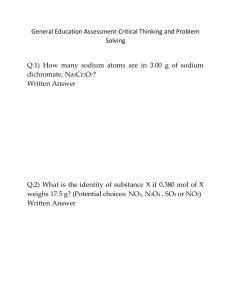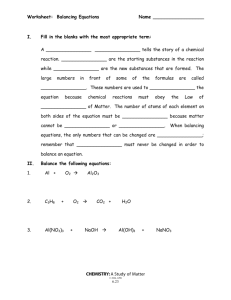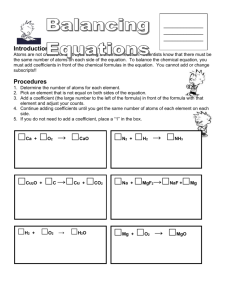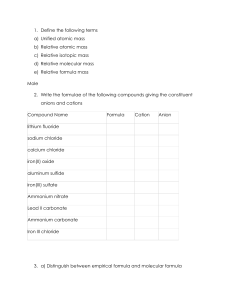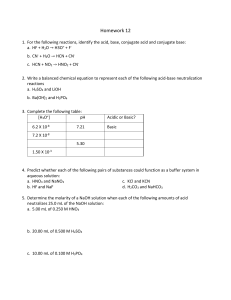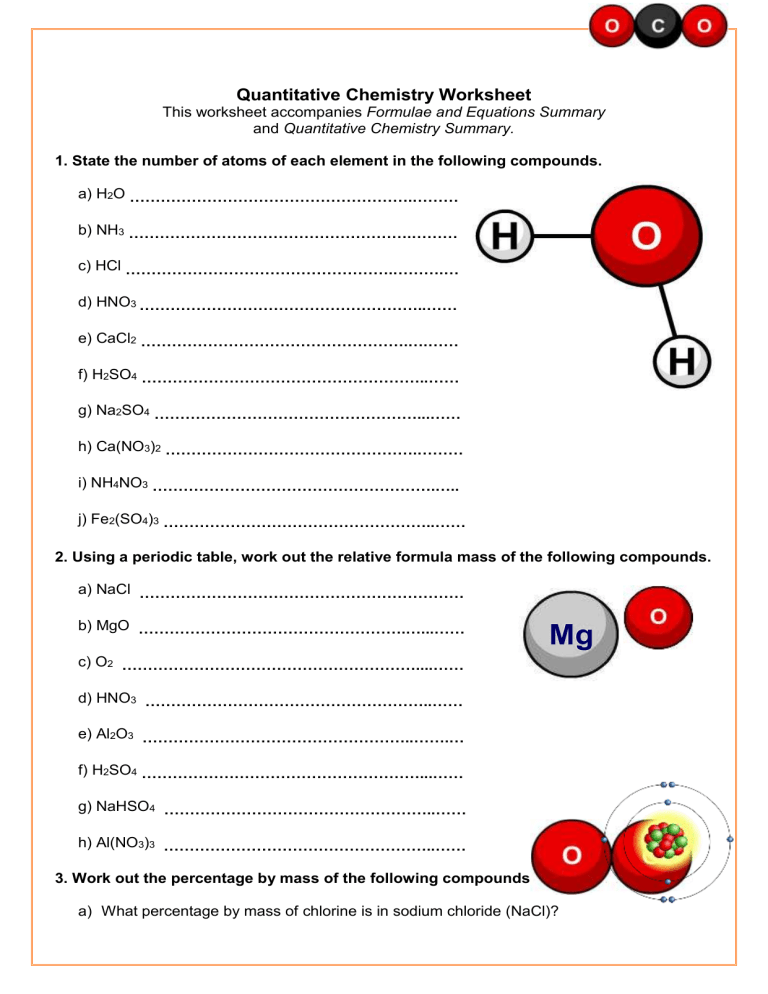
Quantitative Chemistry Worksheet This worksheet accompanies Formulae and Equations Summary and Quantitative Chemistry Summary. 1. State the number of atoms of each element in the following compounds. a) H2O ……………………………………………….……… b) NH3 ……………………………………………….……… c) HCl …………………………………………….……….… d) HNO3 ………………………………………………..…… e) CaCl2 …………………………………………….….…… f) H2SO4 ………………………………………………..…… g) Na2SO4 ……………………………………………...…… h) Ca(NO3)2 ………………………………………….……… i) NH4NO3 ……………………………………………….….. j) Fe2(SO4)3 ……………………………………………..…… 2. Using a periodic table, work out the relative formula mass of the following compounds. a) NaCl ……………………………………………………… b) MgO …………………………………………….…...…… Mg c) O2 …………………………………………………....…… d) HNO3 ………………………………………………..…… e) Al2O3 ……………………………………………..…….… f) H2SO4 ………………………………………………...…… g) NaHSO4 ……………………………………………..…… h) Al(NO3)3 ……………………………………………..…… 3. Work out the percentage by mass of the following compounds. a) What percentage by mass of chlorine is in sodium chloride (NaCl)? ……………………………………………………………..……………………………………………. b) What percentage by mass of nitrogen is in nitric acid (HNO3)? ………………………………………………………………………………………………..…………. c) What percentage by mass of oxygen is in sulfuric acid (H2SO4)? ................................................................................................................................................... d) What percentage by mass of nitrogen is in aluminium nitrate (Al(NO3)3)? …………………………………………………………………………………………….…...…..…… e) What percentage by mass of phosphate is in potassium phosphate (K 3PO4)? ………………………………………………………………………………………….………………. 4. Balance the following equations. H2O → KOH Na + Cl2 → NaCl c) Zn + HNO3 → d) LiOH + H2SO4 e) Fe2O3 + CO f) C2H6 + O2 a) K b) + + Zn(NO3)2 H2 + H2 → Li2SO4 → Fe + CO2 → CO + H2O + H2O 5. a) Calculate the mass of sulfur dioxide produced when 1 kg of sulfur burns in oxygen. S + O2 → SO2 ..………………………………………………………………………………………..……………… …………………………………………………………………………………………………………… …………………………………………………………………………………………………………… b) Calculate the mass of magnesium oxide formed when 25 g of magnesium reacts with oxygen. 2Mg + O2 → 2MgO Mg ..……………………………………………………………………...…………………..…… ………………………………………………………………………………………………… ………………………………………………………………………………………………… ……………………………… c) Calculate the maximum mass of aluminium which can be extracted from 10 kg of aluminium oxide. 2Al2O3 + 3C → 4Al + 3CO2 ..………………………………………………………………………………………..……… …….…………………………………………………………………………………………… ……......…….………………………………………………………………………………… …………………………… d) Calculate the mass of carbon dioxide produced when extracting 100 kg of iron using the equation. Fe2O3 + 3CO → 2Fe + 3CO2 ..………………………………………………………………………………………..……… …...…………………………………………………………………………………..………… ………………….……………………………………………………………………………… …………………………… e) Calculate the mass of sodium chloride formed when 100g of sodium is burnt in chlorine. 2Na + Cl2 → 2NaCl ..………………………………………………………………………………………………… ……..….………….…..……………………………………………………………………… …...……………………………….……..……………………………………………………… …………...………………
